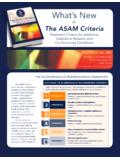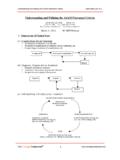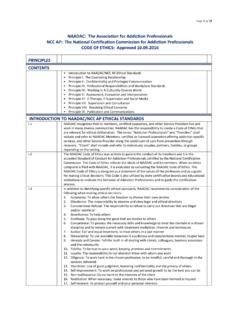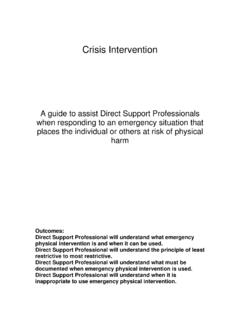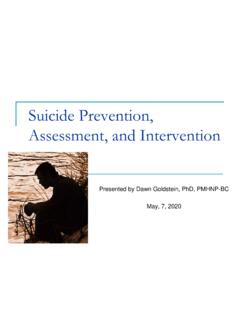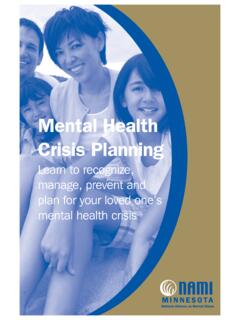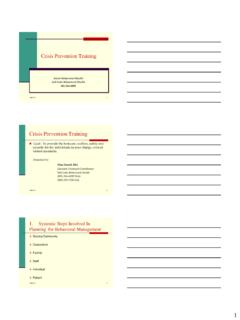Transcription of Brief Intervention: Process and Techniques
1 Brief Intervention: Process and Techniques Rebecca Bullion, LCSW, CIP. January 24, 2018. Thomas Durham, PhD. Director of Training NAADAC, the Association for Addiction Professionals Produced By NAADAC, the Association for Addiction Professionals CE Certificate Cost to Watch: Free To obtain a CE Certificate for the time you spent watching this CE Hours Available: webinar: 1 CEs 1. Watch and listen to this entire webinar. CE Certificate for 2. Pass the online CE quiz, which is posted at NAADAC Members: Free CE Certificate for 3. If applicable, submit payment for CE certificate or join Non-members: NAADAC. $15. 4. A CE certificate will be emailed to you within 21 days of submitting the quiz.
2 Using GoToWebinar (Live Participants Only). Control Panel Asking Questions Audio (phone preferred). Polling Questions Rebecca Bullion, LCSW, CIP. 615-414-2995. Cohesion Intervention Services in Your Nashville, TN. Webinar Learning Objectives 1 2 3. Learning Objective #1 Learning Objective #2 Learning Objective #3. Attendees will apply the 7 Attendees will Attendees will identify 6. steps in the Brief comprehend 3 roadblocks elements of Brief interventions intervention Process to success in the Brief intervention Process Polling Question #1. Have you worked in any capacity conducting interventions in the substance use disorder field? Yes or No Overview of Webinar Agenda 1.
3 Discussion of Brief vs. full intervention 2. Steps of conducting Brief Intervention 3. Team Building/Assessing the Intervention Team Readiness 4. Roadblocks to Successful Intervention 5. Discussion of Family Roles and how they affect the Team dynamics 6. How to address crisis management if needed 7. Informed Consent and Disclaimer review 8. Discussion of Pros and Cons of Brief Intervention Polling Question #2. Have you had previous training in intervention or Brief intervention? Yes or No What Is a Full Intervention? Full intervention usually requires much more planning and preparation time and thorough care is taken on each detail and step involved in getting a client to treatment In Full Intervention, usually more tasks of intervention are handled by the interventionist.
4 Follow-up care time is usually longer in full intervention. What is Brief Intervention? Brief Intervention utilizes the primary Process of intervention inside of an abbreviated time frame. It uses the power of the group in a face-to-face meeting to motivate an IP to get appropriate help Soft Intervention vs. Brief Intervention Definition of soft intervention Places to use soft intervention Tools for soft intervention Some Reasons to Conduct Brief vs. Full Intervention 1. Limited finances of family to spend on intervention. 2. IP is incarcerated or in hospital and transfer to treatment needs to be expedited. 3. Size of intervention team is very small and usual team preparation time is less 4.
5 IP is already very motivated for treatment and group intervention is not necessary. Limitations of Brief Intervention vs. Full Intervention Agenda of the family/team gets addressed as primary agenda vs. agenda of Interventionist. Most families call for an intervention when they are in partial or full crisis mode and want immediate intervention. Interventionist joins with family in expediting the Process which may lessen the desired outcomes for family system change through extra team building and facilitation of change for the family system. Time for attention to detail is limited. Time for support of individual team members is limited. Time for picking best possible resource for treatment may be limited.
6 Steps in Brief Intervention 1. Initial call usually from concerned family member or friend Establish rapport by listening to their concerns for about 5 minutes by allowing them to vent). Start to complete questions on the Intake/Screening Form 2. Schedule Conference Call with potential Intervention Team asap 3. During call debrief team on steps/structure of intervention Process 4. Discuss roadblocks to successful intervention/educate about disease 5. Help them write/edit the love letters, plan transport, pick treatment center, manage insurance benefits 6. Be available during the intervention for phone support 7. Be available for contingency planning phase if needed I.
7 Initial Call from Client/Caller: Time/Date of Call: Location of Caller: II. Identified Pt. Name and DOB: III. Phone Number of Caller: Amount of Time Caller wants to Location of IP: talk on this call (15 minutes pre- interview needed): DOC: Currently Using: YES NO. Detox Need: YES NO. Tips for Working with the Initial Caller Know that this person is often the most aware of the problem Know that this person can often be the most controlling of what kind of help is needed and may not be on target Know that this person can think that they have the situation fully assessed when actually major points have not been factored in Know that this person is overwhelmed often and needs centering Know that this person may want interventionist to take over but can't let go of the control Minimize extensive discussion of all aspects and history of the addiction of IP.
8 Tips for Written Contract It is best to have a written contract outlining duties of interventionist and expectations of the team in order to increase understanding of the Process . Email to client and ask for signature. Use of programs like Doc-U-Sign can help reduce time involvement when clients are in a hurry Don't skip this step Disclaimer concerns Steps for Team Guided Intervention Appoint a Team Lead person who transmits information to all team members and is the interventionist primary point of contact for communication Plan time, date, location of intervention Appoint appropriate person to address insurance/payment issues and make intake plans with treatment center (can be team lead but may be spouse or other person)(can be interventionist as well).
9 Contingency plans for the 72 hours following Intervention with IP if IP. refuses to go Choosing the Treatment Center In full intervention, the interventionist usually makes the recommendations for best fit after doing investigation of level of care needed, financial resources and other logistical issues. In Brief intervention, picking the treatment center may become the job of the team lead or other team member in order to save time. This presents a risk in that the treatment center has not perhaps been adequately vetted by interventionist. This vetting role, again, may be passed to team members if they are able. Disclaimer needs to be applied in this situation.
10 Level of Care Placement Assess as much as possible what level of care seems appropriate utilizing information from the team knowing that ultimately the treatment center will make that call Choose treatment centers for each level of care, ideally both levels inside of one treatment center in order to reduce complications if higher level of placement is needed Be aware that clients will minimize use and cannot be used as a reliable source of information Assessing IP Willingness Initially assessed by the opinion/viewpoint of the caller Continue to assess by speaking with the team during phone conference Speak to client and use motivational interviewing if using an intervention model that supports this Assessing Chief Enabler Willingness Team needs to clearly understand that chief enabler getting on board with intervention 100% is key Key enabler needs consistency in action and

